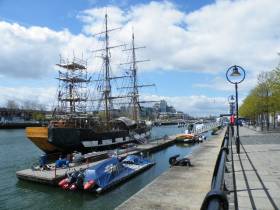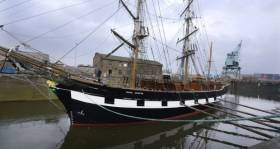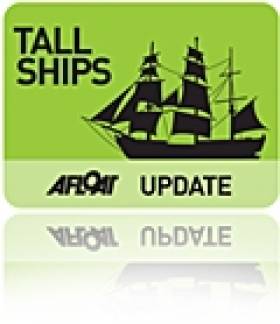Displaying items by tag: Jeanie Johnston
Tours of the Jeanie Johnston Famine ship in Dublin city centre were cancelled this weekend over safety issues arising from young people jumping off the tall ship’s rigging, as RTÉ News reports.
The attraction’s manager John O’Neill said the anti-social posed a danger not only to his staff but to the youths themselves.
Such dangerous diving has been an issue in Dublin’s Docklands for many years, with the Irish Coast Guard previously warning that such activity amounts to “literally jumping into the unknown”.
RTÉ News has more on the story HERE.
Boats are Excluded From State COVID Support Because They are Mobile
It seems logical, boats move, but that is their business. The Department of Finance takes a different view.
It has told boat operators that this mobility excludes them from being given the supports offered to businesses which are landbound – operating from fixed structures - bricks, mortar and buildings – under the Government's Covid 19 pandemic provisions.
That is the core of the disagreement between the Department and the Killary Fjord Boat Tours Company which operates vessels on Ireland's only fjord and on the River Liffey and Grand Canal in Dublin, as well as one that is fixed in position – the Jeanie Johnston moored at Custom House Quay.
 The Spirit of Docklands (50 tonnes, 48 passengers) was custom-designed for the River Liffey in Dublin
The Spirit of Docklands (50 tonnes, 48 passengers) was custom-designed for the River Liffey in Dublin
The Connemara Lady, (150 tonnes, passenger capacity 150), is a tourist operation at Killary Harbour in Connemara on the borders of Galway and Mayo. The Spirit of Docklands (50 tonnes, 48 passengers) was custom-designed for the Liffey, operating between Bachelors Walk and the East Link Bridge. Cadhla (50 tonnes, 65 passengers) was custom-designed for the Grand Canal, operating dining cruises between Mespil Road and the Grand Canal Dock. The tall ship, Jeanie Johnston, recalls Ireland's emigration history and sailed to the USA and Canada before becoming a museum ship at Dublin Port.
 The Connemara Lady, (150 tonnes, passenger capacity 150), is a tourist operation at Killary Harbour in Connemara
The Connemara Lady, (150 tonnes, passenger capacity 150), is a tourist operation at Killary Harbour in Connemara
"Our boat-based businesses are in a plight due to their exclusion from the Covid Restrictions Support Scheme. Indeed, the same applies to all marine tourism infrastructure throughout the country," the company says. "We have been excluded on the basis that our business has been construed as 'mobile' by the Dept. of Finance and as such deemed ineligible for this and other schemes.
"Our boat-based businesses are in a plight due to their exclusion from the Covid Restrictions Support Scheme"
This is despite the fact that, while our business moves as they provide their service we are bound by law and regulations and licensing to operate within a single area at all times."
 Cadhla (50 tonnes, 65 passengers) was custom-designed for the Grand Canal, operating dining cruises between Mespil Road and the Grand Canal Dock
Cadhla (50 tonnes, 65 passengers) was custom-designed for the Grand Canal, operating dining cruises between Mespil Road and the Grand Canal Dock
So, therein is the problem of perception – or understanding.
Micheál O Cionna, the Founder and Managing Director of the company, is my guest on this week's Podcast.
I've asked the Department of Finance to explain their perception and understanding of boats.
Listen to the Podcast below
Jeanie Johnston: Is the Tallship Worth Its Cost?
#tallships - The Dublin Inquirer poses the question is the Jeanie Johnston worth its cost?
It is since 2015 that Dublin City Council inherited the Jeanie Johnston from the Dublin Docklands Development Authority (DDDA) and that has seen the council pump more than €200,000 into repairs for the replica famine ship.
Having cost over €15 million to build the ship’s value has now sunk to €400,000, according to Dublin City Council Administrative Officer Derek Kelly – and officials say that more repairs are needed.
Some councillors are unsure whether more should be spent to save the historical tourist attraction (see recent plans to relocate), or if it should be cut adrift.
An Inheritance
It cost €15.5 million to build the replica ship, a price-tag that was largely covered by central government, according to a council spokesperson. Work started in 1993 and was completed in 2002.
In 2005, the DDDA bought the ship for €2.7 million from Kerry County Council, Tralee Town Council, and food company the Kerry Group, they said.
The ship was part of the €8 million parcel of assets handed over to Dublin City Council from the DDDA after it wrapped up in 2015.
But in the decade between the time when the DDDA bought it, and the agency’s demise, the ship was damaged.
Maintenance of the Jeanie Johnston was, essentially, a low priority for the authority and it was left unused for a number of years, according to the council spokesperson.
To read further on the ongoing work to repair the tallship and more click here.
Epic Homecoming Set for Jeanie Johnston
#tallships - A €15m Irish replica famine ship, Jeanie Johnston may be on the move to a new berth alongside the Epic Ireland museum on the north Dublin quays.
As the UK's The Times writes, Dublin city council is assessing the possibility of moving the ship from Custom House Quay to a location closer to the Seán O’Casey bridge. It said a move would give the ship “a better visual presence when looking from the city centre” and from the southside of the city.
A move would bring the ship closer to Epic, a €12m attraction funded by the Irish-born former Coca-Cola boss Neville Isdell and opened last year with the help of “Maureen O’Hara”, played by Fidget Feet performer Aisling Ni Cheallaigh.
“This proposal is at an early stage and no final… to read for more register details from the newspapers website here.
Dublin City Council Owned Tallship 'Jeanie' Faces Further Delays Until Authority Reopens Swing-Bridge
#JeanieDelayed - Once again delays to relocate tallship Jeanie Johnston to her normal home-berth closer to Dublin’s city-centre on the Liffey’s northside continue to beset the popular visitor tourist attraction, writes Jehan Ashmore.
As previously reported on Afloat, the delays are due to ongoing maintenance work with the iconic Samuel Beckett swing-bridge. The bridge commissioned by Dublin City Council was opened in 2009.
The works have so far prevented the replica 19th century famine-emigrant museum tallship Jeanie Johnston (ownership of DCC) in finally reaching the Custom House Quay. The tallship was originally scheduled to return to this quay this weekend. Until last month the tallship had been drydocked which in itself was a historic event.
Dublin City Council commented to Afloat to say that the ongoing maintenance works on the Samuel Beckett Bridge are due to take place next week on the Monday and Tuesday. During this work it is planned to open the bridge to permit the Jeanie Johnston to proceed up the Liffey to her customary berth. This will merely involve a short hop across the Liffey to the more conducive Custom House Quay given its proximity to the city-centre.
In the meantime the replica museum barque remains berthed further downriver along Sir John Rogersons Quay on the south quays. Guided tours however are running and will remain so up until next Tuesday. Unlike the Custom House Quay’s pontoon berth, tours of the tallship at this current south quay berth are restricted to tidal conditions and given that boarding involves a gangway.
According to Sea-Cruise Connemara, which operate the tallship on behalf of DCC, tour tickets are on sale at Custom House Quay. This is some five minute walk away.
The tourist attraction explores the Jeanie Johnston’s tragic role during the famine which forced thousands of destitute people to emigrate to North America. In all 16 voyages were taken by the tallship between 1847 and 1855 and notably transporting over 2,500 people with no loss of life.
The previous owners of Jeanie Johnston were the Dublin Docklands Development Authority (DDDA) which acquired the vessel in 2005. After more than a decade the Dublin Docklands Development Authority Dissolution Act resulted in the assets of the DDDA (including the replica barque) transferred to Dublin City Council.
As for the Samuel Beckett Bridge, the striking structure was designed by the internationally renowned architect and engineer, Dr. Santiago Calatrava. The structure arrived by barge from where it was constructed in the Netherlands. Its distinctive harp-like appearance has made the bridge an attraction in its own right as it elegantly spans the Liffey lined with glazed buildings from the heady heights of the Celtic Tiger era. The buildings house finance, accountancy and law firms in addition residential appartments.
A revival in construction in this financial quarter has emerged in recent years notably with even higher rise newbuilds than the Celtic Tiger. The current construction underway is part of DCC’s Strategic Development Zone (SDZ). Afloat as previously reported on Dublin's 'London' Landings Docklands in which more will be explored about the relationships of other new buildings and ships that call to the inner old port.
The revival of this new-found confidence along this stretch of the Liffey presents an ever changing skyline. Equally as in the case of the shipping scene with vessels arriving and departing. Among them the odd visiting cruiseship bringing economic activity through tourism.
Reopening of Dublin City Centre Tourist Tallship Deferred
#TallshipTimes - The reopening of a Dublin city centre tourist visitor attraction, the tallship Jeanie Johnston has been deferred by a week, writes Jehan Ashmore.
As reported earlier this week the replica of the 19th century famine-emigrant tallship followed a historic end of era drydocking in the port. The tallship was to have reopened yesterday following a tow to a temporary berth.
It transpires the reopening of tours explaining the emigrant role of the original ship during the Irish famine to north America will begin next Friday, 24 February. This been despite the barque's recent return to a routine berth at Custom House Quay following planned drydocking maintenance.
During a visit to the Jeanie Johnston by Afloat to the drydock, it was clearly evident towards the stern that exposed timber framework remained along with just half a mizzen mast in situ. As for the graving dry-dock dating to 1957, the largest such working facility in the state and in the capital at 200m long is to be decommissioned by the Dublin Port Company.
This is to facilitate DPC’s plans for much needed quay frontage and cargo space for the €227m Alexandra Redevelopment Project (ABR) project. This will be phase one of the port’s Masterplan: 2012-2040.
Following three days of public information days held this week in local community venues on the Masterplan Review, those intending to consult can still do until Tuesday 7th March 2017. Dublin Port is inviting submissions from all those with an interest in the future development of the Port.
DPC have published a Masterplan Review 2017 Consultation Paper and an Environmental Report Consultation Paper. Both documents can also be viewed in hard copy (Monday to Friday, 9am to 4pm) at the offices of Dublin Port Company, Port Centre, Alexandra Road, Dublin 1.
Submissions may be made to Dublin Port Company during the public consultation period in any of the following ways by clicking this information link here.
Jeanie Johnston Almost Home From Historic End of Era Dry-Docking
#DublinsTallship - Jeanie Johnston which became the final ever vessel to use Dublin Port's last working graving dock is to return to her usual city-centre berth this afternoon, writes Jehan Ashmore.
On Monday, the replica of a 19th century famine emigrant barque had departed the 200m graving dock having undergone planned maintenance.
The facility that also was a shiprepair and conversion business is to be decommissioned. Dublin Port are to in-fill the site for the Alexandra Basin Redevelopment ABR project. This will be phase one of the port’s Masterplan to permit largers ships to enter the port and expand capacity.
After been towed from drydock, Jeanie Johnston is currently at a temporary berth along the North Wall Quay Extension next to the Tom Clarke toll-bridge. The bascule-bridge lift is to be raised to facilitate the Jeanie Johnston by heading upriver.
Following this transit, Jeanie Johnston is not to directly head to her routine berth at Custom House Quay. Instead the barque will berth along Sir John Rogersons Quay. From this southside berth the tallship will await clearance subject to specific opening times, before making a transit through the Samuel Beckett swing-bridge.
Once this second transit has been achieved then the 301 gross tonnage tallship will finally reach her berth on the Liffey at Custom House Quay.
According to the operator's website, tours of the replica tallship are to begin this Friday. The original Jeanie Johnston completed 16 trans-Atlantic emigrant voyages between Ireland and north America in the years from 1847 to 1855. Over 2,500 people were transported and notably with no loss of life.
#DryDocking – A replica 19th century famine emigrant tallship built to retrace Irish-north American history, Jeanie Johnston also made her own mark in Dublin Port yesterday as the final ship to use the capital’s last graving drydock, writes Jehan Ashmore.
Following the float-out of Jeanie Johnston from the largest dry-dock in the State at 200m long, the barque’s departure ended another era in Irish maritime industrial heritage. The dry-dock's outer caisson gate was opened for the 301 gross tonnage vessel to ease along to the adjoining Lead-In Jetty.
As the name of this berth suggests, this will no longer be required as since 1957 (opening of graving dock No.2) ships would use this berth in preparation prior to passing through the caisson gate.
In the case of this historic occasion, Jeanie Johnston lay alongside the jetty awaiting tugs to tow the 47m (154ft) overall barque out of Alexandra Basin. The drydocking was to facilitate contractors carrying out planned maintenance. Work however notably remained to be completed towards the stern with final timbers to be put in place to cover exposed timber framework.
As reported in the The Irish Times today, Micheál Ó Cionna, who manages the Jeanie Johnston as a tourist attraction and museum, said the ship would return to its berth with Dublin Port tug assistance and would re-open later this week.
According to the visitor attraction website, the tallship is to reopen this Friday.
Asides this structural area of incompleted work, Jeanie Johnston emerged gleaming with fresh paint on the barque’s distinctive smart black and white hull scheme.
The closure of the dry dock is due to Dublin Port Company’s Masterplan (Review) which includes infilling the drydock. This is to increase more quay space as part of a major €230m Alexandra Basin Redevelopment ABR project. The project is phase one of an ambitious plan to permit considerably larger deep-draft cargoships and cruise liners to enter the port. In addition the works are to increase capacity requiring the new port infrastructure.
As Afloat reported in April 2016, the facility closed having been leased to Dublin Graving Docks Ltd. The port company terminated the lease and as alluded required the drydock site for the ABR project. The final chapter in shiprepair and maintenance in the capital however as it transpired involved Jeanie Johnston which after dry-docking was towed back on the Liffey yesterday afternoon.
The tallship is not at her usual berth along Custom House Quay nearer the city-centre. In the meantime, Jeanie Johnston is berthed upriver beyond the Tom Clarke toll ship-lift bridge. This followed a tow from the dry-dock by the port’s owned tug sisters, Beaufort and Shackleton. The crew's demonstrated skilful manoeuvres despite strong winds to edge the tallship gingerly to quayside.
Jeanie Johnston Departs Dublin Port Graving Dock for Final Time
#PortHistory - Jeanie Johnston made history when at Dublin Port yesterday the tall ship floated out of its graving dock.
As the Irish Times writes the replica 19th century “Famine” ship is the last vessel to be worked on in the port’s graving dock as previously reported by Afloat. The dry-dock is being closed and filled in as part of the €230 million Alexandra Basin project.
The five-year project aims to allow larger ships to routinely call at Dublin, turn within Alexandra Basin and berth as far upriver as East Link Bridge.
Micheál Ó Cionna, who manages the Jeanie Johnston as a tourist attraction and museum, said the ship would return to its berth with Dublin Port tug assistance and would re-open later this week.
Mr Ó Cionna said the closure of the port graving dock emphasised the need for Minister for Heritage Heather Humphreys to save the last docks of this type in the Liffey area – on the Grand Canal Basin. For on this story click here.
Jeanie Johnston Replica Famine Tallship Sinks in Value
#JeanieJohnston - The Irish Times reports that the replica famine tallship, Jeanie Johnston which cost €15 million to build, has sunk in value to €700,000, according to Dublin City Council.
The ship is part of €8 million in cash and assets expected to transfer to the council as previously reported on Afloat.ie once the Dublin Docklands Development Authority is abolished later this year.
The authority bought the ship in 2005 for €2.7 million from Kerry County Council and other shareholders including food company Kerry Group, Shannon Development Company and Tralee Town Council.
The ship, modelled on a 19th century emigrant ship, was commissioned in the late 1990s for £4.5 million. By the time of its completion in 2002, its cost had spiralled to almost €15.5 million, €13 million of which was State funded.
For more on this story about the tall-ship, click HERE.
































































